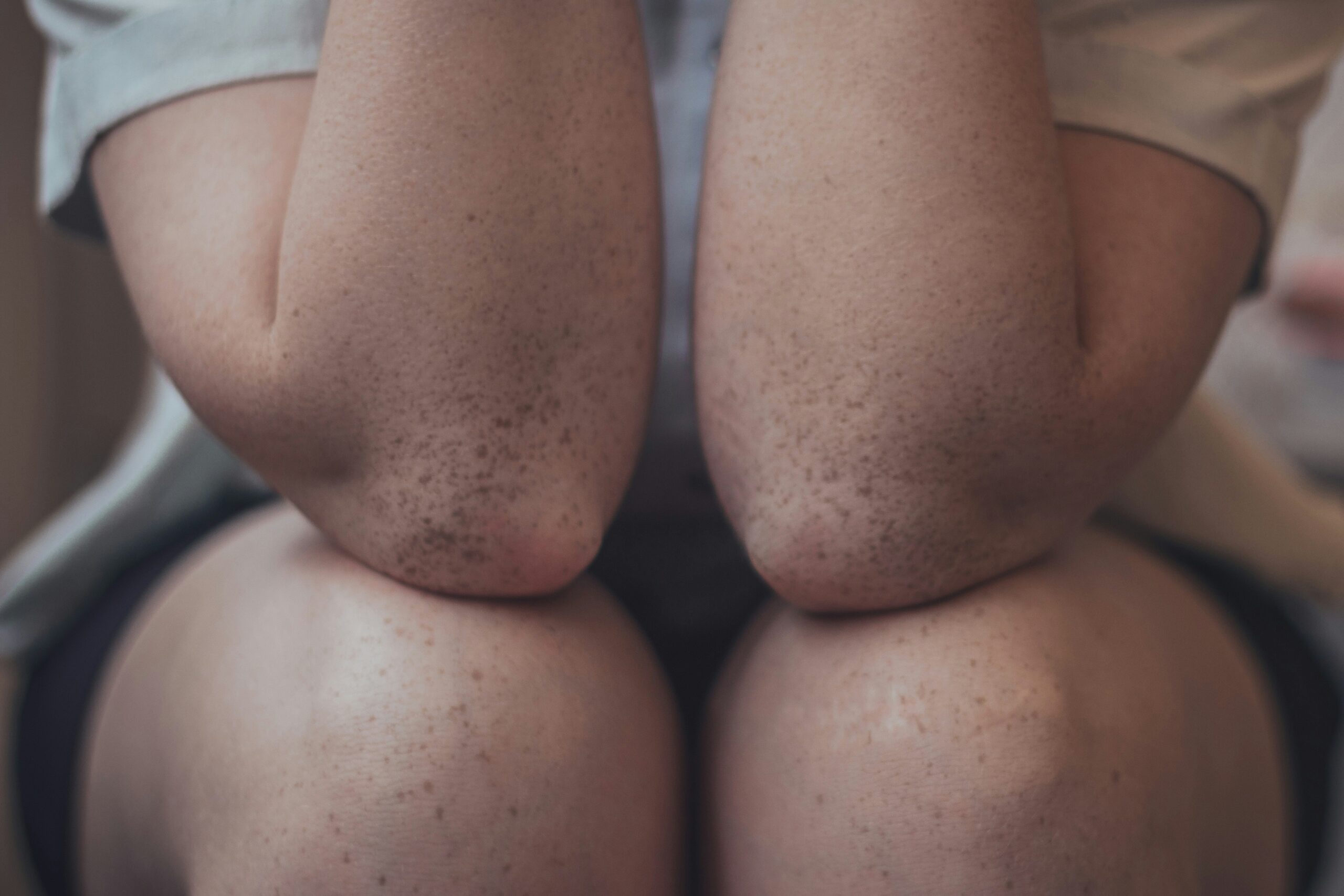Moles are common skin nevi that can be harmless or indicate disease. The medical term for moles is melanocytic nevi (MN). They are circumscribed proliferations of melanocytes in the skin. For the most part, melanocytic nevi are benign and can appear in any mole on a person's skin. Moles appear on the body as early as childhood, but adults can also get new skin lesions. This phenomenon is normal; moles can change color or size with age.
Melanocytes are round or oval in shape and often cluster in groups. Some moles fade over time, while others may get larger. Hair may grow on the moles, and the color of the skin nevi may take on shades of beige, brown, or black. However, it is worth noting that melanocytic nevi can transform and indicate a severe disease. Melanocytes can involve the deeper subcutaneous layer. Therefore, in many cases, moles with characteristic appearance are worth examining.
Modern and noninvasive tools can largely determine a mole's malignancy potential, although they cannot replace histology. Lifelong observation of skin nevi and regular examinations are recommended for people at risk of cancer. Some nevi are described as dangerous, as a malignant tumor can develop on their background. Melanoma can also develop on the skin in an area with no pigmented lesion.

A number of scientists have studied mole formation. They say that moles can originate from pluripotent cells![]() . The cells travel from the neural crest to the skin and undergo terminal differentiation in the dermis and basal layer of the epidermis microenvironment. However, this hypothesis has not yet been completely clarified. It derives from observations linking skin nevi to chronological aging.
. The cells travel from the neural crest to the skin and undergo terminal differentiation in the dermis and basal layer of the epidermis microenvironment. However, this hypothesis has not yet been completely clarified. It derives from observations linking skin nevi to chronological aging.
Other researchers have observed that various factors predispose to the formation of moles. Causes that may predict the development of melanocytic lesions include:
First and foremost, moles are genetically determined skin lesions. Their appearance is under substantial genetic control. Genetic predisposition influences the tendency to form nevi, but deciding which nevi will be inherited is impossible. Familial predisposition also affects moles, which transform into skin cancer.
Environmental factors also play a role in the formation of moles. While genetic control determines the appearance of nevi, ecological exposures affect the number of skin nevi in the form of moles. The most important environmental factor is childhood sun exposure. In addition, the use of SPF filters reduces the development of new moles. Many new moles may appear after summer, which is perfectly natural. However, a sudden rash of nevi may indicate that the skin has been overexposed to the sun.

The number of moles may be related to skin color, as studies have observed that skin moles are much more common in Caucasians than in other ethnic groups. It was also once thought that people with red and blond hair tended to have more moles and other skin lesions, but subsequent studies have contradicted these results.
Another important factor predisposing to the formation of skin lesions is treatments carried out through the use of light. Phototherapy in infancy is a vital risk factor for the development of moles in childhood. Treatments involve irradiating the skin generally all over the body with ultraviolet A rays. Among other things, phototherapy is used to treat psoriasis; however, ultraviolet radiation![]() can cause temporary activation of melanocytes.
can cause temporary activation of melanocytes.
Melanocytes are cells in the human body that produce and store melanin, the skin's natural pigment. Melanin is responsible for the color of the eyes, skin, and hair.
Melanocytic lesions can appear in different areas of the body. They affect the skin, mucous membranes, hair follicles, and internal organs. Melanocytic nevi can appear on the hands, abdomen and chest, back, and genitals, among others. Most often, moles involve the basal epidermis![]() or dermis
or dermis![]() . However, skin lesions can also penetrate deeper layers of the skin and penetrate beyond the subcutaneous tissue into the muscles. Such skin lesions are called deep-penetrating nevi.
. However, skin lesions can also penetrate deeper layers of the skin and penetrate beyond the subcutaneous tissue into the muscles. Such skin lesions are called deep-penetrating nevi.
Moles can also vary in size, often appearing as small skin lesions, while large lesions are relatively rare. They frequently develop on skin exposed to UV radiation from childhood to young adulthood. There are different types of melanocytic lesions. Typical moles are usually oval and well-demarcated from the rest of the skin, having defined borders. Some moles have characteristic features depending on the type of nevus. When atypical features are noted, the moles can be examined to distinguish them from neoplastic lesions.
Melanotic spots, or freckles and sun spots, are also distinguished but are not included in the group of melanocytic lesions. Freckles do not indicate an altered melanocyte count; they are only a limited increase in skin pigment.

Types of melanocytic nevi include:
This melanocytic lesion is also referred to as a Sutton nevus. The term usually describes a several-millimeter-long skin lesion with a regular border outline and, characteristically, surrounded by discolored skin. A hypopigmented rim with a light shade is a characteristic feature of halo nevus. Visually, a light ring is formed around the brown pigment cluster, which gradually expands. Typically, Halo nevus is benign and occurs in children and adults but should be differentiated from malignant skin tumors.
Spitz nevus is characterized by a pinkish or reddish color and swelling. It is typical of fair-skinned people and children. Spitz is a distinct subtype of melanocytic lesions with characteristic histopathological features, some of which overlap with melanoma. Thus, this type of nevus can look very similar to skin cancer. However, most often, these lesions are benign and non-cancerous. It is worthwhile to perform tests to detect the risk.

Miescher's nevus is another nevus, which is commonly called a mole. It is usually brown. The lesion can be smooth or papular and pustular in a dome shape. It usually appears on the face or neck. The nevus is round and soft and may have hair coming out of it. In their standard, healthy form, these pigmented nevi are benign and do not threaten our health. Miescher's lesion is most common in adults over 30 years of age. However, diagnosis is essential because the nevus can be confused with neurofibroma, nodular fibroma, and basal cell carcinoma.
Another type of melanocytic nevus is Meyerson's nevus, which is referred to as an eczematous nevus. This type of nevus is characterized by being surrounded by a small ring of eczema. Eczema is defined as a group of dermatological diseases that are characterized by inflammation of the skin. An acute local inflammatory eczematous reaction often accompanies Meyerson's nevus. Most often, it has an allergic origin. It can be caused by hypersensitivity to one of the allergens or by an innate abnormal response of the immune system to certain external factors.
Moles that may resemble cancerous lesions are worth undergoing diagnostic tests. If doctors notice an atypical appearance of a mole, they may order dermatological tests. Among the tests that play a unique role in the diagnosis of moles are:

Dermatoscopic analysis allows assessment of the pigmentation patterns and structure of skin lesions. On examination, it helps distinguish benign nevi from cancerous lesions. Atypical nevi based on dermatoscopic examination can be divided into various subtypes. Doctors pay special attention to lesions that show features of multiple subtypes![]() , as this may be more consistent with a skin cancer diagnosis.
, as this may be more consistent with a skin cancer diagnosis.
A biopsy is particularly helpful in distinguishing a mole from a cancerous lesion. Examination of the tissue rules out malignant differential diagnoses. The full evaluation can be performed after the complete excision of the lesion, which facilitates analysis. A biopsy that incises only specific portions of the mole may overlook cancerous areas. Therefore, an excisional biopsy![]() is recommended to get a complete picture of the neoplasm. Removing nevi is also a preventive measure, but it is not enough to completely rid the cancerous lesion.
is recommended to get a complete picture of the neoplasm. Removing nevi is also a preventive measure, but it is not enough to completely rid the cancerous lesion.
When preventing the development of atypical moles, no method eliminates the risk. An important factor is not exposing oneself to the sun and using SPF filters, which can minimize the likelihood of developing skin lesions. Also important are regular checks of nevi so that dangerous transformations can be detected.
Patients sometimes get rid of atypical moles to minimize the risk of transformation. In addition, many people get rid of moles for aesthetic reasons. Various treatment methods can reduce pigmentation and improve the cosmetic appearance of nevi without completely removing the cells of the skin lesions. In such cases, the following techniques are carried out:
Surgical removal of moles is performed under local anesthesia. It involves the excision of the suspected mole with a small margin of the surrounding skin. Depending on the mole's size, the invasiveness can vary in degree. If surgical treatment is chosen, various options are available. Moles are removed by curettage![]() or various excision methods. Excision is possible with reconstruction or skin grafting
or various excision methods. Excision is possible with reconstruction or skin grafting![]() .
.
Skin abrasion is a non-surgical option for getting rid of moles. It involves mechanical abrasion of the epidermis and upper layers of the dermis. Dermabrasion is used for various problems, including stretch marks, scars, and other skin lesions. After the procedure, the skin may be irritated and reddened, but dermabrasion treatment can achieve significant smoothing and reduction of hyperpigmentation.
Chemical peeling is a specialized procedure involving controlled epidermal damage using safe chemicals. Medium-depth and deep peels are used on skin lesions such as moles and warts. These peels eliminate epidermal cells and stimulate regeneration and cell renewal processes. However, such treatments may not work on more giant moles penetrating the skin deeper.

Cryotherapy involves freezing a mole using liquid nitrogen. Cold therapy has multidirectional beneficial effects on the body, so this treatment method is used for various problems. Pigmented nevi and other harmless moles can be removed by this method. Freezing the tissue causes damage and necrosis. The cryotherapy procedure is quick and painless but can leave small scars. Cryotherapy of cancerous lesions is also an essential application of cold treatments.
An ablative laser uses a device that emits a beam that works by vaporizing the epidermis and upper dermis and shrinking collagen fibers. The primary technique for removing melanocytic nevi is excision, which produces scarring and an undesirable cosmetic effect. Ablative lasers have the advantage of not causing long-lasting scarring from the elimination of the mole. Laser treatments are controversial, however, as it is suspected that the laser may inadvertently stimulate transformation![]() into cancer.
into cancer.
Moles do not always pose a cancer risk; however, an atypical-looking skin lesion is worth investigating. Some benign moles can transform into malignant tumors, which include:
Melanocytic neoplasms are lesions with abnormal architecture and atypia of melanocytes. The risk of a mole transforming into a neoplasm occurs throughout life. However, a significant minority of nevi transform into cancer. In people with atypical nevi![]() , the risk is much higher. If you want to avoid skin cancer, atypical nevi are considered a predisposing factor and should, therefore, be promptly noticed and diagnosed.
, the risk is much higher. If you want to avoid skin cancer, atypical nevi are considered a predisposing factor and should, therefore, be promptly noticed and diagnosed.
Moles are common skin nevi, which in medical terminology are called melanocytic nevi (MN). Limited melanocytic proliferations in the skin are primarily benign and can appear in any nevus on the skin. Nevi appears on the body in childhood or adulthood. Moles can appear depending on the type but are usually oval with well-defined borders. Nevi can also change color or size with age.
In many cases, nevi with a distinctive appearance are worth examining because they are associated with a higher risk of skin cancer. Modern and non-invasive tools can largely determine a nevus's malignancy potential. Various methods can also remove moles. Lifelong observation of skin nevi and regular examinations are recommended for those at risk for cancer.